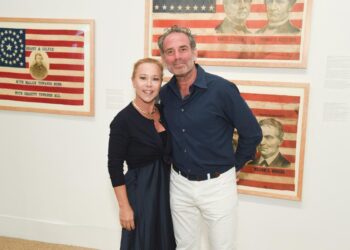Just weeks after receiving a fatal diagnosis in early 2015, world-renowned British neurologist, historian, physician, and author Oliver Sacks decided to spend some of his remaining moments reflecting upon his life story, recounting everything from his childhood in England to becoming what The New York Times dubbed “the poet laureate of medicine.”
Director Ric Burns documented Sacks’ final months for Oliver Sacks: His Own Life, which is screening as part of the 2019 Hamptons International Film Festival.
HIFF is screening Oliver Sacks: His Own Life, which won the Audience Award for Best Documentary Feature, again as part of its Now Showing on Saturday, December 21 at 6 p.m. and Saturday, December 28 at 6 p.m. Both screenings will be held at Guild Hall (158 Main Street, East Hampton).
Oliver started recounting his life story very shortly after his diagnosis. Why was it important for him to capture his legacy?
RB: He was a ferociously closeted person in every respect, except to those people who were really close to him. In which case, he was actually ferociously open. He was a person of extremes and he had spent really his whole life guarding the perimeters from people who he felt would be hostile to him, starting with his mother, who loved him and he loved, but who called him an abomination when he came out to her at 18. He really spent his 20s, 30s, 40s, 50s, 60s, into his 70s very wounded and very guarded. At the same time, almost helplessly open to other people in all sorts of ways.
It wasn’t until he was in his late 70s, early 80s that he said he began to really think about what he had not talked about openly. When he was 80, he wrote the manuscript to an extraordinary book called On the Move, which was a memoir, which he had just finished, but was not yet published when he got this mortal diagnosis. I think there was something about the convergence of circumstances, age, the incredible blessing of finally finding a personal relationship with an extraordinary man named Billy Hayes, which relaxed something in Oliver that had never been relaxed before. The approach of death, not imminent he thought, but nevertheless, at 80, you’re 80, and then he got this moral diagnosis. I think that combination of factors made him double down. If he didn’t do it now, if he didn’t express himself now, it was going to be over. So, both with respect to the manuscript of his still unpublished memoir, and with respect to the filming, which he hoped we would undertake, he really wanted to talk about what his life has meant and what the struggles had been and to be really, I think it’s true to say unswervingly honest about himself, as he had struggled to be with great respect for the many men and women who kind of came under his watch as a neurologist.
So, I think that for all those reasons, there was a kind of urgency, not a hysterical urgency, I think there was a really focused urgency in the last six months of his life, which has been building for a little while to lay all that out there, to leave a record of what he felt. Everyone who knew Oliver said the vector of his life, the narrative of his life as it unfolded and came to conclusion was really remarkable in a way in those last six months. There was sort of a clarity and a focus. A lot of the bullshit kind of fell away. He was still Oliver, but he was very much letting go of the extraneous. That really came true, I think, in the 90 hours of footage we were privileged to shoot with him in the last six months of his life, really, February till June of 2015.
What was it like to capture the legacy of such an iconic subject?
RB: It was a great privilege. I brought an enormous amount of apprehension to it, partly because of the sense of responsibility and partly because I had an initial sensor, he might be kind of a disturbingly narcissistic person, which in that case it would be really hard to be their film biographer. What was fortunate was that the first filming we did with him was five days in a row, 12 hours a day, Monday through Friday, February 9th through 13th, 2015 in his apartment on Horatio Street, surrounded by friends and family members. A kind of rotating group of people over the five days, Billy, his partner, Kate, Edgar, his long time partner of writing and editing and creating books and structuring his life.
What happened was it was a full immersion. It wasn’t like getting to know them bit by bit, it was really kind of all or nothing, and that really helped. By the second or third day, I realized that I was bringing my own kind of ignorant misconceptions, not that they were based on nothing. But, they were based on the fact that Temple Grandin said about Oliver once, she herself autistic and very extraordinarily brilliant and achieved, said, Oliver, is pretty spectrumy himself, by which she meant to say that anybody who really knew him, whether it’s from your own experience, or as a doctor, that there’s a lot going on with Oliver. He paralleled some of the neurological complexities of many of the people that he dealt with, and that could present as self absorption, a kind of lack of responsiveness.
It turned out he had something called prosopagnosia, an inability to recognize faces, which is a very strange thing because it means in the normal intercourse between someone, the way in which you can see them, recognizing and understanding, that was very different in Oliver. He would recognize people in his own building after 20 years because of their dog, not because of their face. So, there is a whole array of let’s call them neuro atypical qualities which Oliver shared with many of his patients, which made him a little bit of a cipher and open to misunderstanding, a misunderstanding which plagued him. Especially in his 30s and 40s and 50s, where he was fired from every job he had, he was held in contempt by fellow neurologists. He was really the most classic square peg in a round hole, certainly that neurology had ever seen.
Besides Oliver, what went into selecting the film’s on-camera interviewees?
RB: The only person we interviewed, other than the people assembled in his apartment before he died, was Lawrence Wechsler, formerly of the New Yorker, who had sought Oliver out really early on as a young writer, and they became lifelong friends. We wanted to go to that very wide ranging group of people, family members, patients, his late in life boyfriend, Billy Hayes, Nobel Prize winning scientists like Eric Kandel, who he knew well, other neuroscientists like Christof Koch. Because he had an extraordinary, capacious, voracious interest and curiosity in chemistry, neurology, in the periodic table, in biology and evolution, and so he accumulated around him, in the course of his life, an incredibly diverse cast of characters. All of whom, again, would say that what was really amazing if you we’re ever at a dinner party at Oliver’s, is that his maid, Yolanda was popped down there next to Christof Koch, the head of Paul Allen’s Brain Institute, next to Shane Fistell, a touretter from Toronto, next to his boyfriend, Billy. There is a sense which was very, very characteristic of Oliver that all of us are different, but all of us share an amazing kinship in that difference, in that irreducible difference which makes us in some sense. There’s a kind of neuro genetic democracy that Oliver was aware we all live in.
It wasn’t that he wasn’t discerning and profoundly ambitious and desiring to achieve, but he saw everyone including himself, exactly on the same human plateau, and beyond human. He saw human beings, animals, plant life, moss, fungus, as being all part of this incredible sort of tree of life and living, that shared vastly, more partly in their irreducible differences, then they were different.
With six decades of Oliver’s work to explore, how did you decide what to focus on?
RB: We wanted to, on one hand, tell the story of his life from the vantage point of his coming to the end of it. We knew that the film had to be structured by two parallel narratives, which are going to obviously come to a convergence at the end. One, the narrative of a North London, English Jew, from a family of high succeeding doctors. Born in 1933, down to 2015, so the story of a life, his life. At the same time, the story of someone trying to come to terms with that life, in the last months and years of his own existence. Those two parallel narratives, which are obviously tightly related, but not quite the same thing, were crucial to it. I think there’s some real powerful, powerful themes in his life, which you very quickly know you’re going to focus on, and you were just coming across again, and again.
He was really trying to chart something which is essentially, absolutely universal and absolutely invisible, which is what it is to be a feeling, as he said in one of his last pieces in The New York Times, to be a sentient, thinking animal on this beautiful planet. By which he meant that here’s this extraordinary mystery for all of us, you, me, all of us, and dogs and spiders in some different way, all of us have a sense of self, and awareness and a point of view. It feels like something to be and that was really data, the subject, the kind of quest of his life. Although he was deeply scientific and deeply interested in all the ways biology could be brought to bear on understanding human experience and existence. But he was really centrally focused on this thing, which is, what is it to be a self. Without any sense that was any Cartesian nonsense that was like endowed by God, came from some invisible place, which we could never understand with profound sense. The awareness that comes back to beings each morning, when any of us wake up is just as physical as saying it’s a thunderstorm or a lightning bug. He was going to be the observer, who used empathy and language and observation to try to track something, which is only each of us ourselves has any direct access to what this interiority is.
Oliver was desperate to form a deep connection with other people’s interiority, however afflicted neuro atypically they may be, and that was his recurrent subject. From the time he was a little boy and his brother Michael became schizophrenic. You know, what is it to be me? What is it to be you inside? And he’s asking that story to remarkable, almost kind of obsessive consistency throughout his whole life, right down to the very end. Once you get that, which is sort of like that shoe drops early, I think, for most people. When you write something about the man who mistook his wife for a hat, you get he’s trying to not just write a technical manual on some neuro atypical circumstance, but rather, what is it like to be a person who may be a man who has prosopagnosia, who could mistake a fire hydrant for a child or a hat for his wife. Oliver was convinced that all neuro atypical conditions had their own sort of temporality, their own way of being. So a touretter was different from someone who was autistic, was different from someone who had parkinsons, who was different from someone who had brain lesions of a certain kind. But, nevertheless, he created not just “a condition,” he created a whole way of being in the world, which he wanted to interrogate and describe and share with other people.
Oliver had to overcome so much in his life, was it difficult for him to reflect on his struggles?
RB: I think at the end for Oliver, who was not a calm person, he reached relative calm and peace with himself. I don’t think he ever achieved the kind of equanimity with respect to his sharing his sexuality with other people, the fact that he was gay. When he introduced us, my crew and me, to Billy Hayes, his partner, for the first time, he said early on in our film, “And here is Billy, a fellow writer that lives in the building and to whom I dedicate this present book.” Everybody should be going like, excuse me, this is a man you’re wildly in love with. You met five years ago, and the two of you had the great fortune of converging late in your life and in the middle of Billy’s.
But no, he could not walk arm in arm with Billy Hayes from Horatio Street to Julius’, the oldest gay bar in New York City, without a deep sense of apprehension and discomfort. So, I think, the stuff all of us carry doesn’t go away. There’s profound reasons why it wouldn’t have for a guy like Oliver who grew up in England, where Alan Turing was chemically castrated, just as Oliver was coming along as a sexual being. Or abominated and cursed by his mother who said, I wish he’d never been born, not that she didn’t still love him. He carried around a lot of stuff and I think that he knew that all of us are some kind of balance of the stuff we finished metabolizing, and come to terms with, and all that stuff that in some sense holds over, keeps drawing a shadow, and that we learn very much as terms of with himself, how he approaches patients, who, at a certain point, they were only going to be healed so much. He knew that he himself is only going to be healed so much and that at some point it’s not about fully untying the knots that are us. But, understanding that they’re going to be somebody so tightly drawn, that they’ll always be there and that we have to find a way to live with them, rather than to cut through.
Is there anything else you would like to add?
RB: We’re thrilled to be coming to the Hamptons! It’s going to be great.
Oliver Sacks: His Own Life can be seen on Friday, October 11 at Bay Street at 8 p.m. and Saturday, October 12 at East Hampton UA1 10 a.m.
The 27th annual Hamptons International Film Festival will take place Columbus Day Weekend (October 10 through October 14).
HIFF is screening Oliver Sacks: His Own Life, which won the Audience Award for Best Documentary Feature, again as part of its Now Showing on Saturday, December 21 at 6 p.m. and Saturday, December 28 at 6 p.m. Both screenings will be held at Guild Hall (158 Main Street, East Hampton).
For more information, visit hamptonsfilmfest.org.






